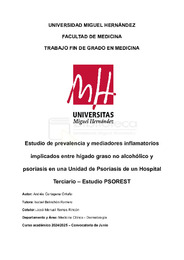Por favor, use este identificador para citar o enlazar este ítem:
https://hdl.handle.net/11000/37735Registro completo de metadatos
| Campo DC | Valor | Lengua/Idioma |
|---|---|---|
| dc.contributor.advisor | Belinchón Romero, Isabel | - |
| dc.contributor.advisor | Ramos Rincón, José Manuel | - |
| dc.contributor.author | Cartagena Ortuño, Andrés | - |
| dc.contributor.other | Departamentos de la UMH::Medicina Clínica | es_ES |
| dc.date.accessioned | 2025-10-27T13:26:11Z | - |
| dc.date.available | 2025-10-27T13:26:11Z | - |
| dc.date.created | 2025-05-08 | - |
| dc.identifier.uri | https://hdl.handle.net/11000/37735 | - |
| dc.description.abstract | Introducción: La psoriasis y el hígado graso no alcohólico son enfermedades con un gran componente inflamatorio y muy relacionadas entre ellas por sus mecanismos patogénicos. El objetivo de este estudio es comparar el estado inflamatorio en pacientes con psoriasis con y sin hígado graso no alcohólico (HGNA) utilizando indicadores de inflamación, así como su relación con las citoquinas y los valores de FIB-4. Material y métodos: Estudio retrospectivo observacional descriptivo transversal que emplea la base de datos PSOREST de 2018, donde se incluyeron pacientes mayores de 18 años con diagnóstico de psoriasis moderada o grave, en seguimiento por la unidad de Psoriasis de un Hospital terciario. Se calcularon los indicadores de inflamación: Ratio Neutrófilos-Linfocitos (NLR), Ratio Monocitos-Linfocitos (MLR), Ratio Plaquetas-Linfocitos (PLR), Índice de Inflamación Sistémica (SII), Índice de Respuesta Inflamatoria Sistémica (SIRI) e Índice Agregado de Inflamación Sistémica (AISI). Resultados: Se estudiaron 217 pacientes, 91 presentaron HGNA. Los pacientes con HGNA fueron significativamente mayores (53 años frente a 43,9 años, p<0,001). También se observó una mayor prevalencia de dislipemia, diabetes y síndrome metabólico en el grupo con HGNA. No se encontraron diferencias significativas en los índices de inflamación entre ambos grupos. Sin embargo, se observó una correlación positiva entre IL-6 y varios índices inflamatorios (NLR p=0,002, SIRI p=0,01, SII p=0,01 y AISI p=0,02). Además, los pacientes con un FIB-4 >1,3 presentaron valores más bajos en PLR, SII y AISI, aunque podría estar influenciado por el uso de plaquetas en los cálculos de estos índices. Conclusiones: Los índices de inflamación en pacientes con psoriasis no permiten diferenciar pacientes con HGNA de pacientes sin HGNA. Existe una correlación leve entre algunas citoquinas y los índices de inflamación. Los índices de inflamación únicamente se correlacionan con valores altos de FIB-4 en aquellos en los que se incluyen las plaquetas. | es_ES |
| dc.description.abstract | Introduction: Psoriasis and non-alcoholic fatty liver disease (NAFLD) are conditions with a strong inflammatory component and are closely related due to their pathogenic mechanisms. The aim of this study is to compare the inflammatory status in patients with psoriasis with and without non-alcoholic fatty liver disease (NAFLD) using inflammation markers, as well as their relationship with cytokines and FIB-4 values. Material and Methods: A retrospective observational descriptive cross-sectional study was conducted using the 2018 PSOREST database, which included patients over 18 years old with a diagnosis of moderate or severe psoriasis, followed by the Psoriasis Unit of a tertiary hospital. Inflammation markers were calculated: Neutrophil-Lymphocyte Ratio (NLR), Monocyte-Lymphocyte Ratio (MLR), Platelet-Lymphocyte Ratio (PLR), Systemic Inflammation Index (SII), Systemic Inflammatory Response Index (SIRI), and Aggregated Index of Systemic Inflammation (AISI). Results: A total of 217 patients were studied, 91 of whom had NAFLD. Patients with NAFLD were significantly older (53 years vs. 43.9 years, p<0.001). A higher prevalence of dyslipidemia, diabetes, and metabolic syndrome was also observed in the NAFLD group. No significant differences were found in the inflammation indices between the two groups. However, a positive correlation was observed between IL-6 and several inflammation indices (NLR p=0.002, SIRI p=0.01, SII p=0.01, and AISI p=0.02). Additionally, patients with FIB-4 >1.3 had lower values in PLR, SII, and AISI, although this could be influenced by the use of platelets in the calculation of these indices. Conclusions: Inflammation indices in patients with psoriasis do not allow for distinguishing between patients with NAFLD and those without. A mild correlation was found between some cytokines and inflammation indices. Inflammation indices only correlate with high FIB-4 values in those that include platelets in their calculation. | es_ES |
| dc.format | application/pdf | es_ES |
| dc.format.extent | 24 | es_ES |
| dc.language.iso | spa | es_ES |
| dc.publisher | Universidad Miguel Hernández | es_ES |
| dc.rights | info:eu-repo/semantics/openAccess | es_ES |
| dc.rights.uri | http://creativecommons.org/licenses/by-nc-nd/4.0/ | * |
| dc.subject | Psoriasis | es_ES |
| dc.subject | hígado Graso No Alcoholico | es_ES |
| dc.subject | Inflamación | es_ES |
| dc.subject | Citoquinas | es_ES |
| dc.subject | Indicadores de Inflamación | es_ES |
| dc.subject | FIB-4 | es_ES |
| dc.subject.other | CDU::6 - Ciencias aplicadas::61 - Medicina | es_ES |
| dc.title | Estudio de prevalencia y mediadores inflamatorios implicados entre hígado graso no alcohólico y psoriasis en una Unidad de Psoriasis de un Hospital Terciario – Estudio PSOREST | es_ES |
| dc.type | info:eu-repo/semantics/bachelorThesis | es_ES |

Ver/Abrir:
CARTAGENA_ORTUÑO,_ANDRÉS,_TFG.pdf
2,29 MB
Adobe PDF
Compartir:
 La licencia se describe como: Atribución-NonComercial-NoDerivada 4.0 Internacional.
La licencia se describe como: Atribución-NonComercial-NoDerivada 4.0 Internacional.
.png)